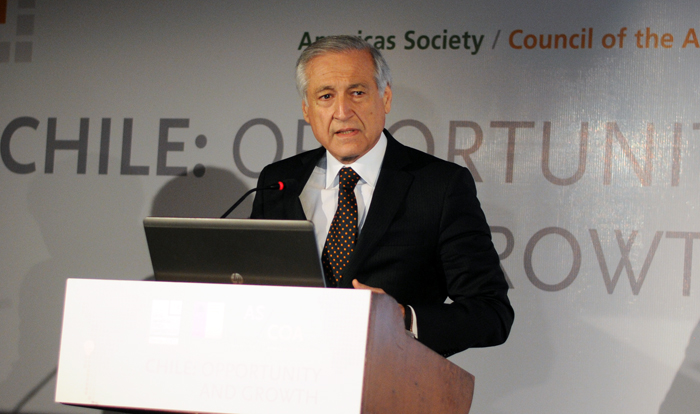Santiago 2015 Blog: Five Facts about Chile's Open Market
As the Pacific Alliance implements massive tariffs reductions, Chile’s foreign trade experience stands out.
With the Pacific Alliance implementing a 92 percent cut in tariffs on July 20, Chile, Colombia, Peru, and Mexico are leaping ahead on trade as an economic bloc. The countries’ framework agreement going into effect helps boost the potential of the Pacific Alliance, which represents 37 percent of Latin America and the Caribbean’s GDP and 45 percent of its foreign direct investment.
Both as part of and outside of the Pacific Alliance, Chile has been a Latin American pioneer when it comes to having an open-market economic strategy. AS/COA Online looks into what you need to know about the country’s trade agenda.
1. Chile has 24 foreign-trade agreements (FTAs) with 63 economies around the world.
The government’s General Directorate for International Economic Affairs (DIRECON) annual report on the country’s foreign trade explains that 94 percent of Chile’s exports go to countries with bilateral agreements already in effect. When it comes to imports, 91 percent of the country’s purchases originate from these 63 economies. The result: Chile paid only 0.9 percent on average in international trade tariffs in the last year. Seventy percent of the country’s total trade in 2014 was tied to its five main partners: China, the European Union, Japan, Mercosur, and the United States. Overall trade represented nearly 65 percent of Chile’s GDP in 2013.
2. Chile’s exports grew in recent years.
Last year, the country saw a 5.1 percent decrease in overall trade, but Chile’s exports have increased by 6.4 percent annually between 2009 and 2014. Last year, trade with the United States increased an average of 10.6 percent, totaling $23.5 million—15 percent of Chilean foreign trade. Mining makes up 54.2 percent of Chile’s exports and copper as much as 50 percent. Falling commodity prices in 2014 contributed to the export contraction in the last year.
|
Watch Minister Muñoz discuss Chile's global strategy LIVE, |
3. In the Americas, Chile was an early adopter of free trade.
According to DIRECON, since the 1990s, insertion in global markets has been a significant economic growth strategy, as well as one of the country’s foreign policy goals. The country reduced its tariffs from 15 to 11 percent in 1991, and went through a legislative process to keep reducing them until 2003. Today in general, imports tariffs are at 6 percent.
With nearly 4,000 miles of coastline, Chile also participated early on in trade relations with Asia. The country is an original signatory of the P4 agreement—a precursor of the Trans-Pacific Partnership (TPP)—signed with Brunei, New Zealand, and Singapore in 2005. It acts as a champion of TPP negotiations today. “We are a small country,” said Chilean Deputy Trade Minister Andres Rebolledo during TPP negotiations in the Philippines in May this year. “Some people say that in Chile we breathe foreign trade.”
4. Chile is making moves to get closer to Mercosur.
Despite the country’s partnership with the Pacific Alliance, Chile holds strong economic ties with Mercosur. Nearly 50 percent of Chilean foreign direct investment and 7.6 percent of the country’s exports go to Mercosur. Its trade with the bloc, totaling $15.2 million in 2014, still surpasses trade with countries of the Pacific Alliance, at $9.1 million. And the Southern Cone bloc represents 56 percent of Latin America’s GDP.
Chile’s Foreign Relations Minister Heraldo Muñoz said in La Tercera that the country values trade with the Pacific and the Atlantic, and that Pacific Alliance and Mercosur are not in opposition. “We have different models to integrate ourselves into the global economy, but there are many issues in common,” he said, making the point for countries to create more infrastructure to facilitate trade between the two blocs.
5. Chile wants its small and medium enterprises (SMEs) to participate in foreign trade.
This year, the federal government opened 15 centers to assist small- and medium-sized enterprises in increasing exports. According to ProChile, more than 600 SMEs participated in workshops seeking information on how to start exporting. Today, 63 percent of Chile’s SMEs export to other Latin American countries and the country saw 551 companies initiating exports in 2014. The main destination was the United States, followed by Peru, Bolivia, Brazil, and Colombia.








